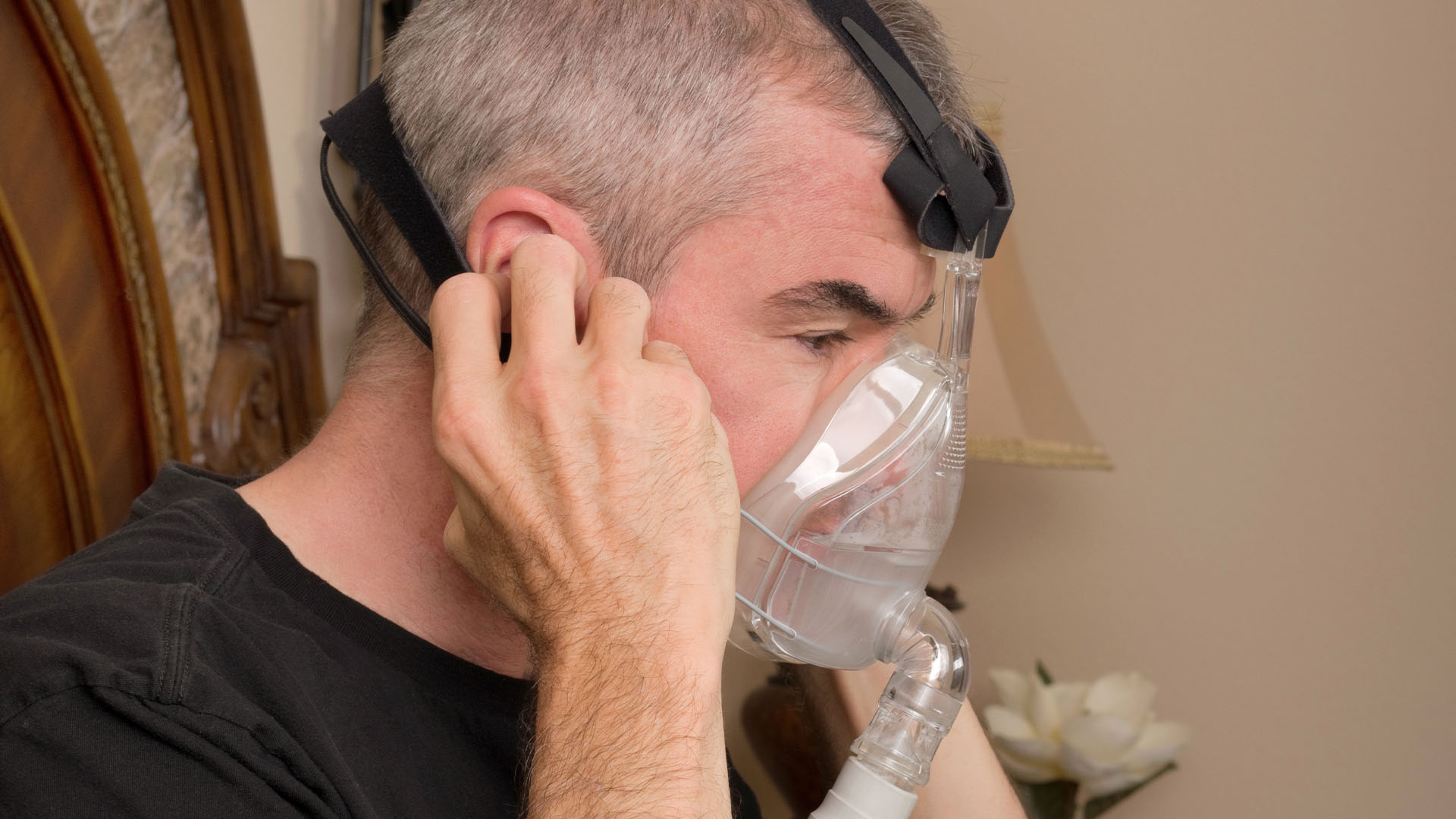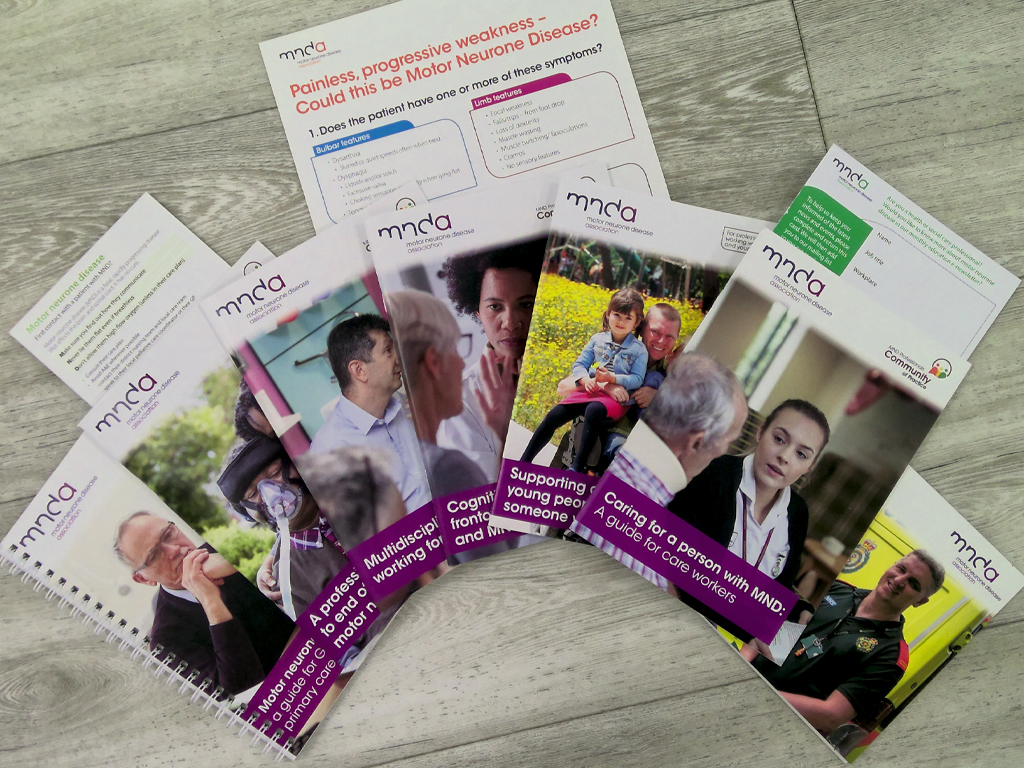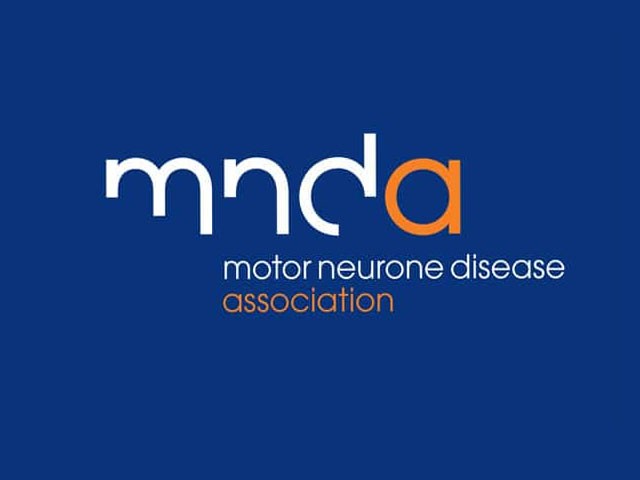
This information is for health and social care professionals.
Muscle weakness in MND will usually progress to affect the respiratory muscles. Respiratory insufficiency, often accompanied by chest infection, is the usual cause of death in MND.
The specialist team should assess and review respiratory function regularly, and assist in managing symptoms. Assisted ventilation can improve quality of life and survival, although it cannot actually slow the progression of MND.
This information covers the evaluation and management of respiratory symptoms in MND.
Download our information sheet for detailed information
Watch our respiratory training film
View our respiratory information for people with or affected by MND
Respiratory symptoms in MND
Signs and symptoms
Early referral to a respiratory specialist is vital if one or more of these occur:
- breathlessness
- orthopnoea
- recurrent chest infections
- disturbed sleep
- non-refreshing sleep
- nightmares
- daytime sleepiness
- poor concentration and/or memory
- confusion
- hallucinations
- morning headaches
- fatigue
Signs:
- increased respiratory rate
- shallow breathing
- weak cough
- weak sniff
- abdominal paradox (inward movement of the abdomen during inspiration)
- use of accessory muscles of respiration
- reduced chest expansion on maximal inspiration.
People with MND may not complain much of breathlessness and, as they often lack mobility, signs of breathlessness due to exertion may be subtle. Night-time symptoms are often an early indicator of respiratory inefficiency. Ineffective breathing when lying down at night (orthopnoea) can lead to an imbalance in blood gases and a build-up of carbon dioxide (CO2).
As a result, the person with MND may:
- complain of waking with a headache, feeling unrefreshed or 'hungover' and not having slept well
- fall asleep during the day
- be difficult to rouse from sleep
- seem confused when they wake up.
Note: people with MND may also experience problems with sleep resulting from reduced mobility, muscle cramps, swallowing problems and anxiety.
Assessing respiratory function
Monitoring respiratory function will help the health professional and the person with MND to reach decisions about management in a timely way.
It is also important because:
- effective management of respiratory function is likely to have a positive impact on quality of life for the person with MND
- it may prevent an acute respiratory emergency, or inappropriate action being taken in the event of an emergency. If someone presents in hospital with rapidly decompensating ventilatory failure, intubation or a tracheostomy may be carried out.
As part of the initial assessment to diagnose MND, or soon after diagnosis, tests should be performed to establish the baseline respiratory function.
Tests may include:
- pulse oximetry (SpO2) – to measure the level of oxygen in the blood (at rest and breathing room air)
- forced vital capacity (FVC) or vital capacity (VC) – to find out the volume of the lungs from a full breath in to a full breath out
- sniff nasal inspiratory pressure (SNIP) or maximal inspiratory pressure (MIP) – a test of the strength of the muscles used to breathe in.
These tests should be carried out by a health professional who has the knowledge and experience to perform them. If the person with MND has severe bulbar impairment (weakness in the tongue, mouth, throat) or severe cognitive problems, it may be difficult to choose the right mask or mouthpiece to use for these tests. As a minimum, a pulse oximetry should be carried out.
Respiratory function tests should be performed every two to three months, but this may vary depending on:
- whether there are any signs or symptoms of respiratory impairment
- the rate of progression of an individual’s MND
- the person’s preference and circumstances.
Because respiratory function testing monitors progression, it may be frightening for someone with MND. However, it can promote discussion of the options and potential intervention.
Referral to specialist respiratory services
Referral should be made to the specialist respiratory team to perform an arterial or capillary blood gas analysis if the person with MND has percutaneous oxygen saturation (SpO2) equal to, or less than 94% (or 92% if they have known lung disease).
Referral to a specialist respiratory service is also indicated when:
- a person has sleep-related respiratory symptoms, despite the SpO2 being within normal limits
- the arterial partial pressure of carbon dioxide (PaCO2, measured from a blood sample) is greater than 6 kPa: in this case, an urgent referral is indicated
- they have symptoms or signs of respiratory impairment despite the PaCO2 equal to or less than 6 kPa
- they have symptoms or signs of respiratory impairment despite a normal overnight pulse oximetry.
Guidelines suggest non-invasive ventilation (NIV) should be considered once FVC falls to 50% of the predicted estimate for the individual. Yet many people with MND experience nocturnal hypoventilation well before this point. No one test is best for monitoring or indicating the ideal time to start NIV.
Planning ahead
Advance care planning
Effective management of the respiratory symptoms of MND requires some understanding of the person’s wishes for care, including end of life care. Initial and regular opportunities should be given to the person with MND (and, where appropriate, their carer/family) to discuss, in a sensitive way, decisions for end of life. This should take place whether or not someone decides to have assisted ventilation.
If someone is considering assisted ventilation, discussions need to take place in relation to continuing or withdrawing this intervention. The progressive nature of MND means the person will continue to deteriorate physically, despite ventilatory support. The treatment may be started to help with night-time symptoms but this can, over time, lead to 24-hour dependence. The person with MND may have strong views on this.
For further information, see: Palliative and end of life care
Gastrostomy
Monitoring respiratory function will help to ensure that placement of a gastrostomy tube, if needed, is performed in a timely manner. Respiratory evaluation is necessary prior to any surgical procedure requiring sedation, such as percutaneous endoscopic gastrostomy (PEG). Earlier placement is recommended while the individual is well enough and their respiratory function is adequate to undergo this procedure.
For further information, see: Nutrition and gastrostomy
Cognition/capacity
Some people with MND will experience mild to severe cognitive change, and a proportion will have frontotemporal dementia. For these people, and others with different factors that limit their cognitive function or mental capacity, careful consideration needs to be given to the appropriate management of any respiratory impairment. The individual’s ability to weigh up the various treatment options and give informed consent will be important.
For further information, see: Cognitive change and frontotemporal dementia
Advance Decision to Refuse Treatment (ADRT)
An ADRT allows people to make decisions to refuse treatments or have treatment withdrawn, including those treatments that sustain life. When appropriately recorded as part of advance care planning, a decision by someone with MND to discontinue the use of ventilation is legally binding, and these wishes should be followed.
For further information, see: Palliative and end of life care
Managing respiratory symptoms
Effective management of respiratory function is likely to have a positive impact on quality of life for the person with MND.
Positioning
It is important to find positions that make it easier for the person with MND to breathe. The ideal position is usually upright or slightly reclined, with the arms supported, rather than lying down. A semi-reclined position may be achieved by using a riser-recliner chair with good arm support, or a wheelchair with tilt-in-space. This position allows the diaphragm to move more freely and efficiently. In bed, it may help to raise the head, perhaps with more pillows or a profiling bed.
Relaxation and anxiety management
Massage and aromatherapy massage may be considered for people with MND who are anxious, short of breath or in the terminal stages of life. Relaxation techniques may be helpful for the relief of anxiety.
Use of a fan or open window
Some people with MND find that movement of air around the face sometimes helps when they feel breathless.
Fatigue management
The aim is for the person to conserve energy so they can do what is important for them. An occupational therapist can advise on adjusting activities to reduce the amount of energy needed to perform them.
Use of a walking frame
Some people with MND have found the use of a three or four wheeled walking frame helpful. The support provided by the frame fixes their arms and therefore the shoulder girdle. With the person’s weight supported by the aid, this helps them to make better use of the muscles used to breathe.
Breathing techniques
A respiratory physiotherapist can give advice on exercises to maximise lung capacity, muscle elasticity and protect against partial lung collapse and infection.
Just in Case Kit
The MND Just in Case Kit is designed to hold medication for the relief of anxiety, choking and breathlessness. Its presence in the home can provide tangible evidence for people with MND and carers that fears have been addressed and practical help is at hand.
Palliation of symptoms
Not everyone will choose to have assisted ventilation, or can tolerate this intervention. As part of palliative care, symptoms such as breathlessness will need to be managed. Increasing doses of medication and increased levels of sedation may be required to control symptoms at the end of life.
This will also be necessary if the person with MND requests withdrawal of non-invasive ventilation (NIV).
Assisted ventilation
Some people with MND will use assisted ventilation. Please see next heading.
Assisted ventilation
Effective management of respiratory function is likely to have a positive impact on quality of life for the person with MND.
Non-invasive ventilation (NIV)
This is a method of providing ventilator support to a person with MND using a close-fitting mask that may cover the nose and/or mouth. The ventilator detects when the person with MND tries to take a breath and delivers an extra flow of air to increase the volume inhaled. The machine can also be set on different modes, for example, to give extra breaths.
A trial of NIV can be offered if the person’s symptoms and the results of respiratory function tests indicate they are likely to benefit from the treatment. It is important to discuss both the benefits and limitations of the intervention with the person with MND (and, where appropriate, their carer/family). It will be necessary to provide training for the person with MND and any carers, and advice around secretion management and cough management (if needed).
When starting NIV, ideally there should be gradual acclimatisation during the day when the person is awake, regular treatment at night will then usually begin. The time of using the machine will build up as necessary.
Sheffield Institute for Translational Neuroscience (SITraN) has developed NIV4MND, an online toolkit designed to support professionals involved in the respiratory management in MND. It provides information to support the delivery of respiratory care to people living with MND, focussed on delivering effective NIV. They have also developed MyBreathing, an educational website for people with MND, about breathing support. It gives an insight into the options available, with a focus on NIV. It includes videos of real life experiences to help support people to make a decision about whether to use NIV.
Tracheostomy ventilation
Some people with MND will be fully ventilated via a tracheostomy, where an opening is created at the front of the neck so a tube can be inserted into the trachea and connected to a ventilator. The tube can also be used to remove secretions in the throat and trachea.
Tracheostomies can result in hospital stays of several months while care packages are arranged and care staff are trained.
Some units are reluctant to offer a tracheostomy ventilation electively due to the need to provide specialist care in the future, which may not be possible to deliver at home. Thought must be put into supported discussions with the person with MND and, where appropriate, their carer/family.
Withdrawal of assisted ventilation
Motor neurone disease (MND) is a progressive and terminal disease that attacks the motor neurones, or nerves, in the brain and spinal cord. Respiratory muscle weakness occurs eventually in everyone with MND.
When someone uses non-invasive ventilation (NIV), there will come a time when respiratory muscles fail to such an extent that ventilation is insufficient to alleviate symptoms or to correct blood gas abnormalities. In such situations, a discussion may take place about whether it is appropriate to continue using NIV.
Assisted ventilation (NIV or invasive ventilation via tracheostomy) may also be withdrawn according to wishes recorded in an Advance Decision to Refuse Treatment (ADRT). Withdrawal of assisted ventilation should be carefully planned so that symptoms can be managed to avoid distress or discomfort. Medication will be used for palliation of symptoms.
Many hospice doctors have experience in managing the process of withdrawing ventilation and may be called upon if needed for support and information. It has been recognised that withdrawal of ventilation can be very challenging for professionals.
Guidance for professionals
The Association for Palliative Medicine of Great Britain and Northern Ireland has published professional guidelines:
Withdrawal of Assisted Ventilation at the Request of a Patient with Motor Neurone Disease
Oxygen use warning
Oxygen should be used with caution in the presence of respiratory muscle weakness, because this weakness can lead to the retention of carbon dioxide (hypercapnia) rather than hypoxia (inadequate levels of oxygen in the body).
In this situation, non-invasive ventilation may be the most appropriate treatment, as oxygen therapy can lead to further respiratory depression.
However, when oxygen levels are low, oxygen may sometimes be used with caution and appropriate monitoring – preferably under guidance of the person’s specialist team with arterial blood gas monitoring.
Cough management
Difficulty in coughing can be due to weakness in inspiratory, expiratory and bulbar muscles. A respiratory physiotherapist can prescribe the most appropriate cough management regime for the person with MND and teach techniques to help them to cough more effectively.
Cough augmentation
Cough augmentation techniques may be offered to people with MND who cannot cough effectively. These techniques can enable expectoration of phlegm or mucus from the throat or lungs, thus reducing the likelihood of A&E admission and emergency intubation.
The NICE guideline on MND recommends:
- unassisted breath stacking and/or manual assisted cough as first-line treatment
- assisted breath stacking (eg using a lung volume recruitment bag with a one-way valve) for those with bulbar dysfunction or whose cough is ineffective with unassisted breath stacking
- if available, use of a mechanical insufflation-exsufflation machine (sometimes known by the brand name CoughAssist), if assisted breath stacking is not effective and/or during a respiratory tract infection.
Mechanical insufflation-exsufflation (MI:E)
MI:E is often referred to as CoughAssist. This device supports and enhances the ability of weakened inspiratory and expiratory muscles in order to improve a person’s cough and aid secretion clearance. Use of MI:E has been shown to reduce the incidence of chest infections, and furthermore reduce the likelihood of emergency hospital admissions. However, the benefits may be limited for someone who has severe bulbar impairment.
MI:E may be started once a person has experienced repeated respiratory infections. Once MI:E has been set up, people are advised to use the device on a daily basis to get maximum benefit and to prevent the onset of further respiratory infections.
MI:E is used with either a tight-fitting face mask, a mouthpiece, tracheostomy or endotracheal tube. Additionally, MI:E can be used in different modes, which helps to improve synchronisation between the patient and the machine, improves patient comfort and therefore treatment effectiveness. A respiratory specialist will be able to prescribe the exact treatment regime needed.
Training should also be provided to the person with MND and any family/carers who may operate the device. The provision or loan of MI:E machines varies from region to region and sometimes servicing and maintenance can be problematic. If problems are experienced, contact the local MND Association Area Support Coordinator (ASC) who may be able to help.
Avoidance of infections
The specialist respiratory team can advise on strategies to avoid infections. Repeated aspiration and poor lung function can leave a person prone to chest infections and pneumonia. It is important to have contact with a speech and language therapist who can assess and advise about swallowing ability. People with MND should be offered prophylactic pneumococcal and influenza vaccinations.
There may be a place for early use of antibiotics, if this is what the person with MND wants.
Secretion management
For information about managing saliva problems in MND, see:
Information sheet P3 – Managing saliva problems in motor neurone disease
An oral suction unit may be used to help with saliva and secretion management. For further information see:
Information sheet P9 - Oral suction
Page last updated: July 2021
Next review: July 2023


